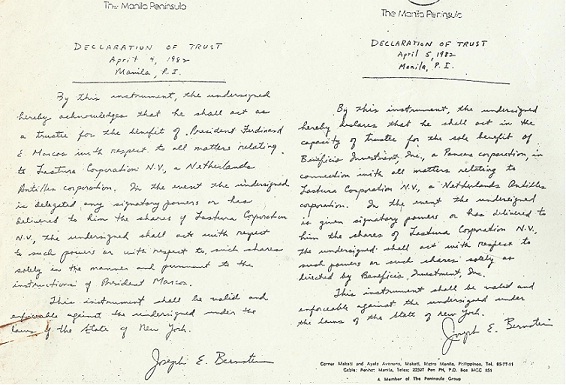The Latest from Ellen Tordesillas
|
Posted: 06 Jan 2013 04:53 AM PST

Imelda Marcos loves jewelry. Photo from http://imeldific2012.blogspot.com/2012/09/imelda-marcos-muse-of-manila-iron.html
As PCGG Chair Andres Bautista said, the job could be continued by
the Department of Justice. The reasons he gave, one of which as that
Marcos- loot- hunting by the 200-man agency is no longer cost effective,
makes sense.
So far, in its 27-year existence the PCGG has recovered $4 billion
(P164 billion), only a tiny fraction of what was estimated to be a $10
billion loot in 1986. Just imagine how much the unrecovered would be
worth by now including the interests.
The executive order creating
the PCGG was the first issued by President Cory Aquino on Feb. 28, 1986,
three days after the Marcos fled early evening of Feb. 25, 1986 as
millions of Filipinos rose in a bloodless revolution called People
Power.
The PCGG was supposed to prevent the Marcos from spiriting money and other forms of wealth they had stashed during the more than 20 years that they were in power. The creation of the PCGG was the basis by the Swiss Federal Court to freeze some of the accounts identified to belong to the Marcoses.
The PCGG was supposed to prevent the Marcos from spiriting money and other forms of wealth they had stashed during the more than 20 years that they were in power. The creation of the PCGG was the basis by the Swiss Federal Court to freeze some of the accounts identified to belong to the Marcoses.
The PCGG may have lost its luster by now, the fault of abuses and
incompetence not only by its personnel but also by a number of the
people who when placed in power post-Marcos turned out to be as greedy
and corrupt.
One of the stories I remember
was, as the Marcoses were rushing out of the Malacañang to the waiting
helicopter parked at the Pangarap House grounds that would bring them
Clark Air Base where a C-130 was waiting that would bring them to Guam
and to Hawaii, there were a lot of documents and pearls that fell out of
the several pieces of luggage they were carting away. Two of those
documents later turned out to be the “smoking gun” evidence that led to
the recovery of the four buildings in New York worth $350 million.
The documents were the declarations of trust handwritten by Joseph E.
Bernstein on a Manila Peninsula letterhead. The first declaration of
trust dated April 4, 1982 stated that Bernstein, a New York real estate
broker, would act as trustee for former president Marcos with respect to
Lastura Corp. N.V., a corporation registered in Netherlands Antilles.
The second declaration of
trust, dated April 5, 1982 stated that Bernstein was the trustee of
Beneficio Investment Inc., a corporation registered in Panama which in
turn owned Lastura Corp.
With the smoking gun evidence, the Bernstein brothers, Joseph and
Ralph, admitted having fronted for the Marcoses in the purchase of the
New York buildings.
But there were also accounts of looting of the loot in Malacañang of some members of the so-called yellow group.
One of the intriguing testimonies of Dr. Teresita Reyes,
dermatologist of Margarita “Tingting” Cojuangco, wife of Jose “Peping”
Cojuangco, brother of Cory Aquino, during the 1991 trial in New York of
the racketeering case against former First Lady Imelda Marcos, was about
several Louis Vuitton valises containing jewelry that they took out
from the bedroom of Imelda.
The valises were loaded into vans that drove to Reyes’ house in Dasmariñas Village in Makati.
Some members of the Reformed the Armed Forces Movement who saw the loading of the valises in the van reported to then Defense Minister Juan Ponce-Enrile, who led with Philippine Constabulary Chief Fidel Ramos,the coup de’etat against Marcos.
Some members of the Reformed the Armed Forces Movement who saw the loading of the valises in the van reported to then Defense Minister Juan Ponce-Enrile, who led with Philippine Constabulary Chief Fidel Ramos,the coup de’etat against Marcos.
Enrile reportedly went to the
Dasmariñas destination of the valises and saw the society matrons
excitedly, like kids, trying Imelda’s jewelry.
Those jewelry (no one’s sure
if everything was accounted for) are now with the Central Bank and
referred to as the Malacañang collection. The Philippine government has
been negotiation with the U.S. auction house, Christie’s.
Last November, there was a story in the New York Times about Imelda’s former aide, Vilma Bautista, accused
of art theft. She was caught trying to sell off painting by the masters
that used to house occupied by Imelda Marcos. One of the painting she
was able to sell was “Le Bassin aux Nymphéas” (1899) by Claude Monet to a
London gallery for $32 million in September 2010.
A lot of those unrecovered
Marcos ill-gotten wealth are out there, if not in banks, in the hands of
some people. They cannot stay hidden forever.
We hope they would surface and returned to the Filipino people in our lifetime.


No comments:
Post a Comment